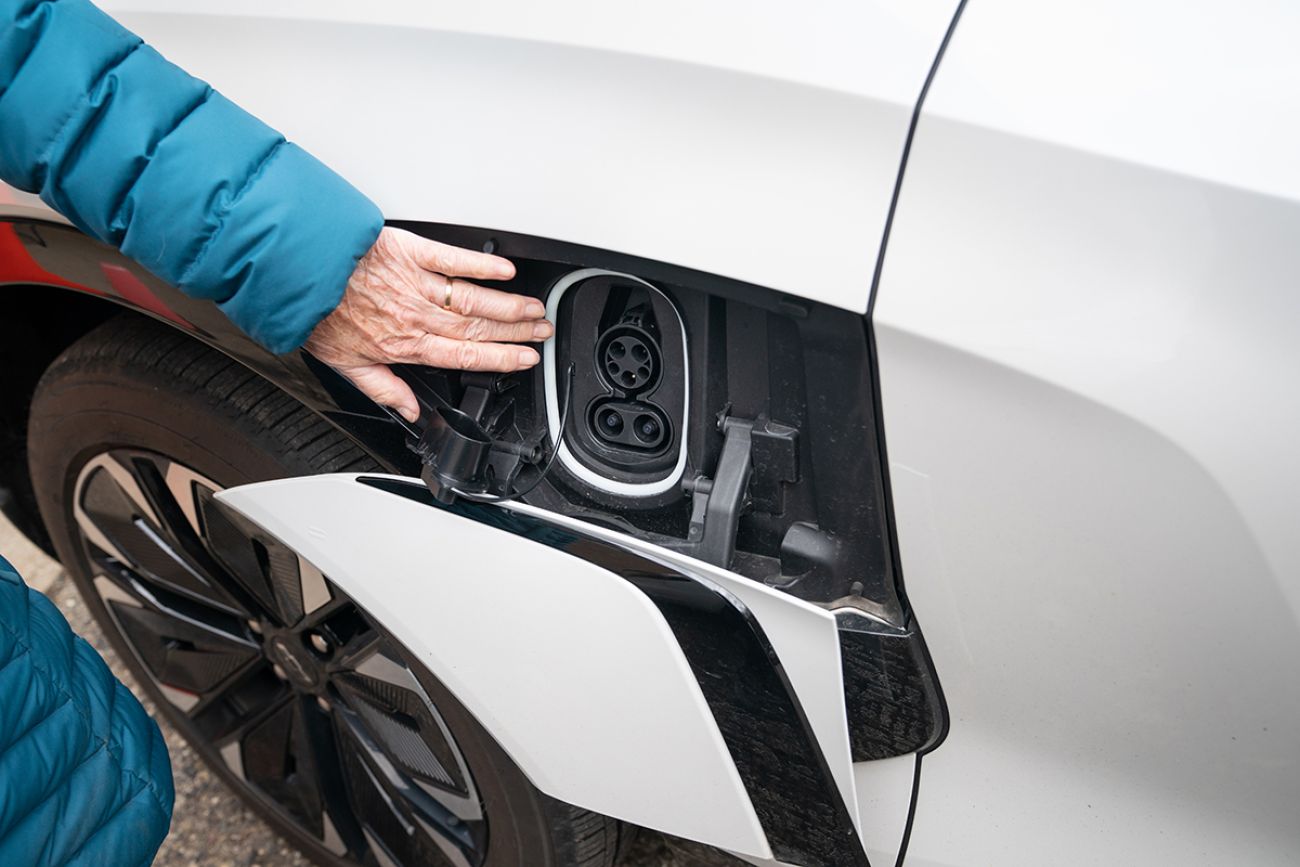Michigan to invest $110M in EV chargers. At $134K a plug, it won’t go far

- Armed with $110 million in federal money, Michigan is about to spend big on EV charging
- But at nearly $134,000 per plug, the money won’t go far toward Michigan’s goal of 100,000 chargers by 2030
- It’s not clear how the remaining chargers will get built, or who will pay
In the next five years, Michigan will make a big push to equip the state with public electric vehicle fast chargers that proponents say are essential to the EV transition and, thus, the global climate and the state’s automotive jobs.
It has $110 million in federal dollars for the cause, several times more than Michigan’s dedicated spending on EV chargers to date.
But a Bridge Michigan analysis of early grants shows that with a price-per-plug that rivals the mortgage debt on an average Michigan home, the money won’t go far.
Michigan has so far paid nearly $134,000 for each plug point, which means unless costs come down, the federal funds will buy about 800 of them spread across 200 locations over the next five years.
That’s 8% of the roughly 10,000 publicly-accessible fast chargers (plus 90,000 slower, less expensive ones) that Michigan wants by 2030 in order to achieve Gov. Gretchen Whitmer’s goal of putting 2 million EVs on the road.
Related:
- EV transition a slow go in Michigan. It needs 100,000 chargers, has 3,300
- Michigan's auto industry awaits an EV revolution in flux
- Researchers say a copper shortage could imperil Michigan’s EV future
- Michigan automakers get breathing room on EVs. Bigger political battle looms
So far, federal data shows Michigan has just 756 fast-charging plugs and 2,568 slower ones scattered across the state.
“We have a long way to go,” said Amy Rogghe, executive director of the nonprofit Michigan Electric Vehicle Alliance. A swift EV transition is possible, she said, but “we just need more funding.”
The high cost illustrates the daunting task Michigan faces as its government, automakers, utilities and other key players try to steer drivers toward a technology seen as crucial to slowing climate change and bolstering Michigan’s key industry.
“Everything has to align,” said Douglas Jester, managing partner of the energy consulting business 5 Lakes Energy, from upgrades to the electrical grid, to rising consumer enthusiasm, to a steady stream of “critical minerals” to build EV batteries and, yes, a dramatic expansion of the charging network.
But with fast-charging ports costing so much, it’s not clear who will pay for the rest.
Lack of chargers a recipe for ‘unhappy people’
The surge of public money comes from the National Electric Vehicle Infrastructure program (NEVI), a $7.5 billion push by President Joe Biden’s administration to build fast chargers at 50-mile intervals along the nation’s highways and in other key locations.
The administration wants to nearly triple America’s public charging infrastructure in the next six years, to a mix of half-a-million fast and slower chargers. Its investment comes at a pivotal moment for Michigan.
The state’s automakers are moving toward EVs, motivated by political and regulatory pressure to reduce automobiles’ contribution to climate change, the allure of government money and existential dread as Chinese competitors prepare to flood the global market with cheap, high-quality models.
“The world is going to go to electric vehicles,” Jester said. If the U.S. is left behind in that change, “there's significant risk to Michigan’s prosperity.”
Meanwhile, Gov. Gretchen Whitmer wants to get roughly a quarter of the state’s drivers into EVs by 2030. Doing so, she says, would protect automotive jobs and reduce the personal vehicle emissions that make up one-sixth of America’s carbon footprint.
“Michigan put the world on wheels, and remaining the global leader in mobility and electrification depends on our ability to work together proactively to address future challenges,” Whitmer said as she announced the 2 million EV goal.
But the state’s drivers seem hesitant to make the transition. EVs represent just 0.5% of vehicle registrations in Michigan, or about 43,000 cars and trucks. EV market share in Michigan is well below the national average.
It’s widely understood that “range anxiety” is a big part of the problem. That is, many drivers hesitate to buy an EV, for fear they’ll run out of power on the road with nowhere to charge.
“If we had this massive (EV) adoption rate and the charging infrastructure was way behind, we’d just have a lot of really unhappy people,” said Charles Griffith, climate and energy program director of the Ann Arbor-based Ecology Center, who co-chaired a state workgroup focused on greening the transportation sector.
Why Tesla drivers have an easier time
“Range anxiety” is a widespread problem for EV owners — unless they drive a Tesla. Here’s why:
The Texas-based company began building out a proprietary charging network well before the rest of the industry got serious about public charging. Tesla’s network of 25,000 Superchargers accounts for more than half of all U.S. fast chargers.
But after recent deals between Tesla and other automakers from Ford to Rivian, drivers of many brands can, or will soon be able to, use Superchargers by obtaining a plug adapter from their car’s manufacturer.
To address the challenge, the state Council on Future Mobility estimated Michigan’s current network of 3,324 charge ports needs to grow thirty-fold by 2030 — an addition of more than 16,000 chargers every year.
Of those, 1 in 10 must be the superfast, expensive kind.
Last year, Michigan gained just 335 charging stations. Just over 100 of them were fast chargers.
The influx of federal money is seen as crucial to picking up the pace. And indeed, an increase of 800 ports will more than double Michigan’s current fast-charging network. But that’s still nowhere near the 2030 goal.
“All we can do, at least on my end of things, is with the money that we have, how can we install as many chargers as we can?” asked Steve Minton, the Michigan Department of Transportation project manager, who is overseeing Michigan’s use of the federal money.
“It’ll be up to the policymakers to figure out where we go from there.”
Why does it cost so much?
Michigan’s $134,000-per-port price is middle of the pack compared to neighboring states.
Of the Great Lakes states that have begun doling out federal NEVI grants, Wisconsin is paying the least, at an average of $93,952 per port, according to data provided to Bridge Michigan. New York is paying the most, at $181,818.
Loren McDonald, CEO of the analyst firm EVAdoption, attributed the high and widely varied costs to new technology that hasn’t yet achieved economies of scale, and an electrical grid that sometimes needs upgrades before it can handle the power load associated with EV chargers.
“They’re almost bespoke,” McDonald said. “There are companies trying to make them a viable businesses that are selling a couple a month.”
Advocates also note that infrastructure is simply expensive. Reconfiguring and repairing Interstate 696 in metro Detroit from Southfield to Farmington, for instance, is expected to cost $275 million.
In comparison, Minton said, “this seems small scale.”
Gas pumps, too, cost hundreds of thousands of dollars to install, said Mark Griffin, president of the Michigan Petroleum Association/Michigan Association of Convenience Stores. The difference is that businesses can absorb those costs, because a steady stream of customers ensures the investment will pay off.
Without public or utility subsidies, chargers would be a money-losing venture in many areas of Michigan, because they don’t yet get enough traffic to recoup installation costs, said Abass El-Hage, whose Detroit-based company, Red E, is Michigan’s biggest NEVI winner so far, with $5.2 million worth of awards.
But, he noted, that’s beginning to change.
In densely populated areas with lots of EVs, such as parts of metro Detroit, west Michigan and Traverse City, El-Hage said, “projects are already financially viable without any incentives.”

If it leads to more EV adoption, the upfront cost to subsidize chargers could save society money in the long run. Health-care costs from breathing toxic automotive exhaust are $120 billion each year in the U.S., and climate damages from tailpipe carbon dioxide emissions amount to billions more.
But skeptics, including Cathy McGeen of Oxford, say the high public subsidy for chargers only decreases interest in buying an EV.
McGeen, who drives a Ford F-250, said she resents the government spending taxpayer dollars to “push one product over another.”
“The free market should choose whether EVs move forward,” she said.
Industry analysts expect charger costs to come down over time as technology improves and the industry grows, similar to what has happened with solar panels. That, combined with more EV uptake, should eventually make charging a viable business without government subsidies.
But nobody seems to have a clear answer about how many chargers the public must subsidize, and for how long, before that happens.
It’s likely far more than the 800 plug points NEVI will fund, said Griffin, of the petroleum and convenience store association.
For the gas stations that make up his membership to independently invest in chargers, he said, far more EVs need to be on the road, and charger prices “will have to come drastically down.”
That means reaching the Whitmer administration’s goal of 100,000 chargers by 2030 probably won’t happen without additional public investment — an idea that is deeply divisive among voters and lawmakers.
Michigan lawmakers have repeatedly downsized Whitmer’s requests to spend more on chargers. And Biden’s likely presidential challenger, former President Donald Trump, has vowed to take aim at pro-EV policies starting on his first day in office, contending EVs will “kill” the U.S. auto industry.
Michigan Environment Watch
Michigan Environment Watch examines how public policy, industry, and other factors interact with the state’s trove of natural resources.
- See full coverage
- Subscribe
- Share tips and questions with Bridge environment reporter Kelly House
Michigan Environment Watch is made possible by generous financial support from:
Our generous Environment Watch underwriters encourage Bridge Michigan readers to also support civic journalism by becoming Bridge members. Please consider joining today.
See what new members are saying about why they donated to Bridge Michigan:
- “In order for this information to be accurate and unbiased it must be underwritten by its readers, not by special interests.” - Larry S.
- “Not many other media sources report on the topics Bridge does.” - Susan B.
- “Your journalism is outstanding and rare these days.” - Mark S.
If you want to ensure the future of nonpartisan, nonprofit Michigan journalism, please become a member today. You, too, will be asked why you donated and maybe we'll feature your quote next time!






